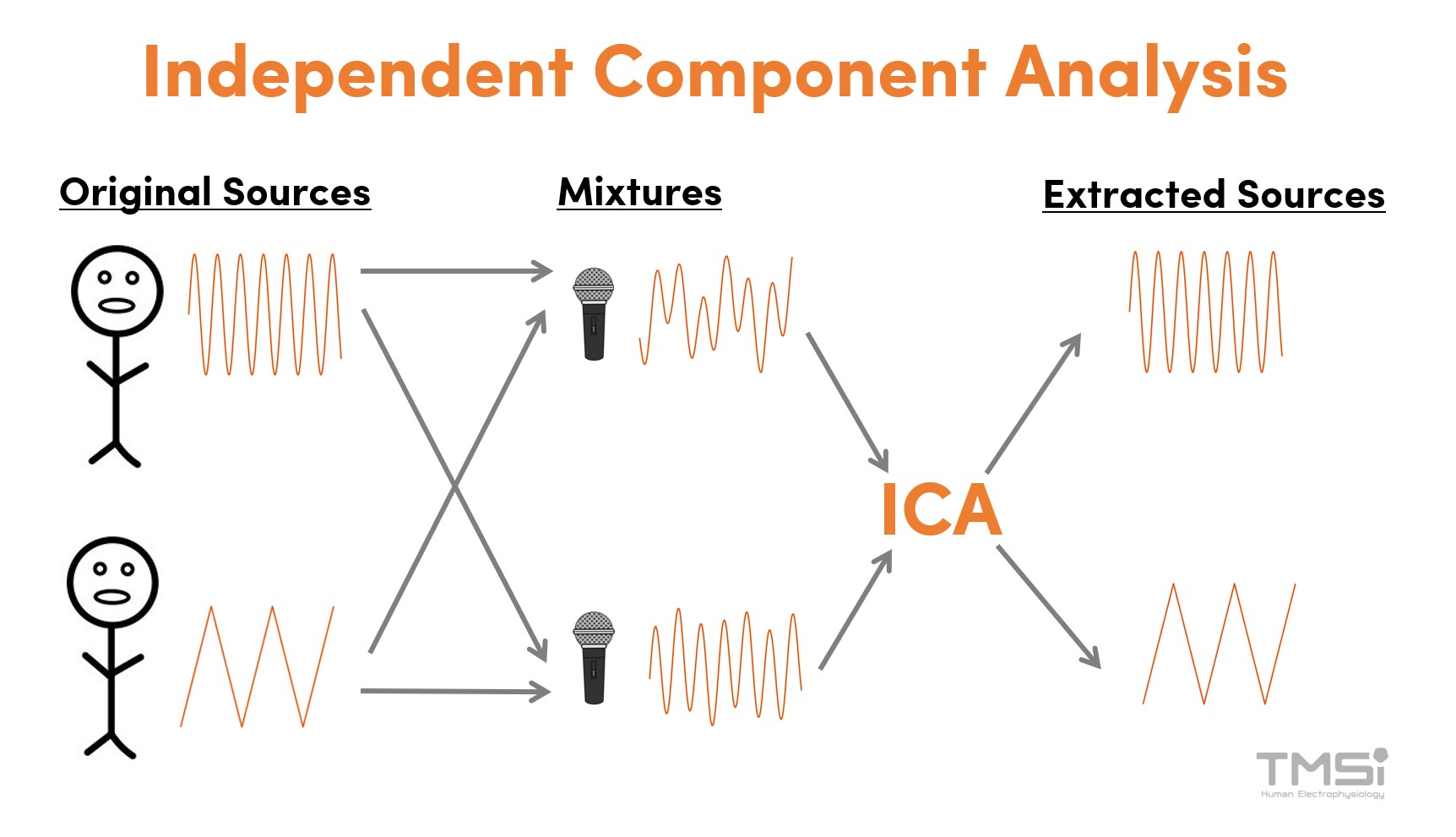Background and Application of ICA
Eye movements and eye blinks are major sources of physiological EEG artifacts. The amplitude of the blinking artifact is generally much larger (in the order of hundreds of microvolts) compared to that of EEG activity (a few to tens of microvolts).1 Eye movement artifacts are hard to prevent. The subject can be instructed to not blink and to look in one direction, but this can increase the cognitive load of a subject and is not always possible.2 Post-processing algorithms like Independent Component Analysis (ICA) can be used to remove the artifacts without removing the affected data parts.
What is ICA and when to use it?
Independent Component Analysis is a signal processing technique that can be used to separate independent source signals from a measurement with several sensors recording the mixed signals of the different sources. ICA is a special case of blind source separation. By identifying the different components of the data, ICA can be used to remove artifacts from the data without removing the affected data part.
A standard example of the use of ICA is that of a room with multiple people talking in a room and multiple microphones recording. The different microphones will pick up a linear mix of the different sound sources. Independent component analysis can be used to separate the recordings from the microphones into different independent sound sources (Figure 1).

Figure 1: Independent Component Analysis illustration adapted from here
The same principle can be used for EEG data, where different electrodes record the electrical activity of different sources (activity of different parts of the cortex, eye blinks and movements, muscle activity etc.). After the separation of the different sources, one can exclude the sources of the artifacts and reconstruct the sensor signals with the artifacts removed.
ICA is often used to remove eye movements from EEG signals but can in principle be used to remove various kinds of artifacts, such as ECG artifacts, line noise etc. In contrast to other artifact removal techniques, such as regression, no artifact reference signal is required. In addition, the removal of brain activity due to contamination of the reference signal with EEG activity is avoided.
How does it work?
Independent component analysis assumes the data to be a linear mix of statistically independent, non-gaussian sources which are simultaneously measured by the different sensors. This can be mathematically represented as X = A S, where X is the measured data, S is the independent sources and A is the mixing matrix representing the linear mixture of the different sources generating the data.
Similarly, this can be turned around in S = W X, where the W is the unmixing matrix. Here the measured signals X are unmixed into the independent components S. The idea of ICA is to solve this equation such that the different sources are maximally independent, which is either done by minimizing the mutual information or maximizing the non-Gaussianity of the different sources. Various algorithms can be used to perform ICA, which differ in the method used to calculate the independent components.


Figure 2: Raw EEG signals with eye blink artifact (1st image) Same EEG signal with ICA reconstruction (2nd image; use right arrow)
Once the independent components are reconstructed, one can analyze them for unwanted components generating artifacts. By zeroing out these components while applying the mixing matrix to the different sources, one can generate the signal at the electrodes while rejecting the artifacts (Figure 2).
Conclusion
Independent Component Analysis can be used to remove artifacts, such as eye blinks, from EEG data. The technique can be used for various types of artifacts and does not require a reference signal.
TMSi designs electrophysiological amplifiers for EEG research. To aid you in removing eye movements from your EEG signals with ICA, TMSi has provided an example script in Python. Please read this knowledge base article for the step-by-step walkthrough.
References:
1. Croft RJ, Barry RJ. Removal of ocular artifact from the EEG: a review. Neurophysiol Clin. 2000;30(1):5-19. doi:10.1016/S0987-7053(00)00055-1
2. Ochoa C, Polich J. P300 and blink instructions. Clinical Neurophysiology. 2000;111(1):93-98. doi:10.1016/s1388-2457(99)00209-6
3. Repairing artifacts with ica. Repairing artifacts with ICA - MNE 1.5.1 documentation. (n.d.). https://mne.tools/stable/auto_tutorials/preprocessing/40_artifact_correction_ica.html
4. Independent Component Analysis for artifact removal. EEGLAB Wiki. (n.d.). https://eeglab.org/tutorials/06_RejectArtifacts/RunICA.html